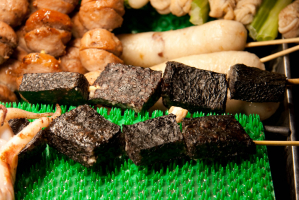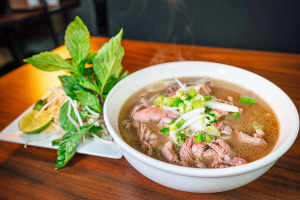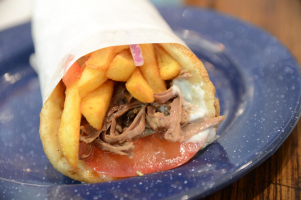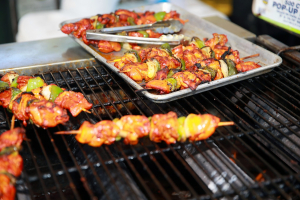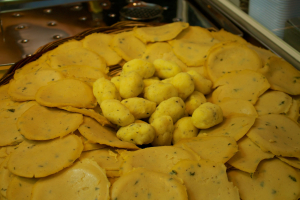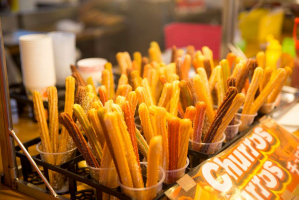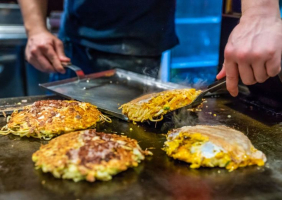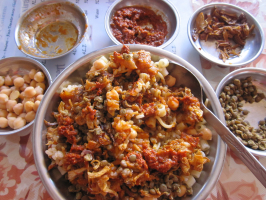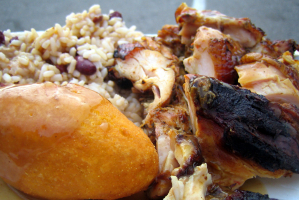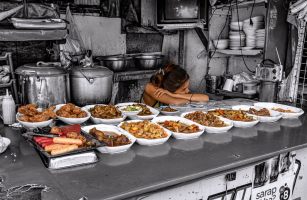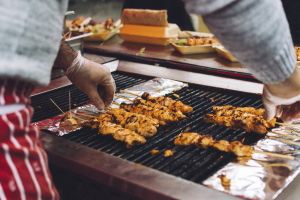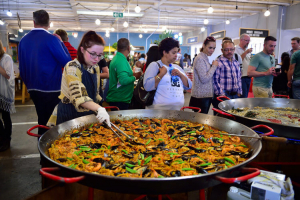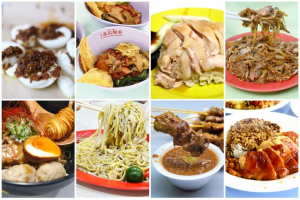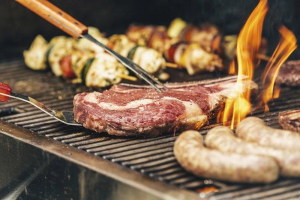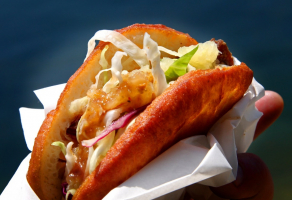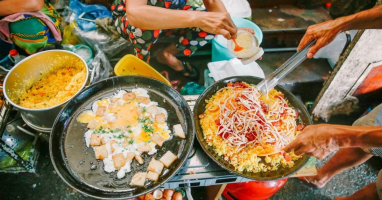Top 15 Most Popular Indian Street Foods
Discover India's top 15 street foods with us. From Pani Puri to Samosa and Jalebi, it's a journey through vibrant flavors and regional traditions. Whether ... read more...you're a food enthusiast or curious about Indian cuisine, come explore the tastes that define India's streets.
-
The first item on the list of the top 15 most popular Indian street foods is Pani Puri, also known as Golgappa or Puchka in different regions of India. It is a beloved and iconic Indian street food. This delightful snack consists of small, hollow, crispy puris, each filled with a spicy and tangy mixture. The filling typically includes mashed potatoes, sprouted mung beans, and a blend of spices, along with tamarind chutney for a sweet and sour kick.
The real magic of Pani Puri lies in its name, which translates to "water in fried bread." The dish is incomplete without the star of the show: the flavored water. This aromatic, spicy, and tangy water, known as pani, is made from a concoction of tamarind, mint, and other spices. Each puri is filled with this flavorful liquid just before consumption.
Pani Puri is not just a treat for the taste buds but also an experience for all the senses. The crispness of the puris, the explosion of flavors in the mouth as you take a bite, and the burst of the tangy water make it an irresistible street food favorite. It's not just a snack; it's a social experience, with friends or family gathered around the vendor, creating lasting memories while savoring these delightful mouthfuls.
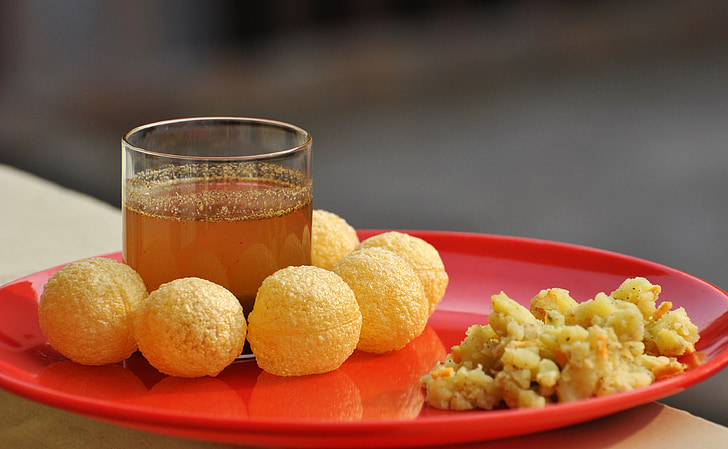
Screenshot of https://www.pickpik.com/search?q=pani+puri Video by Village Cooking Channel -
Samosa, a popular Indian street food and snack, is a savory pastry that has found its way into the hearts and taste buds of people worldwide. This triangular-shaped delicacy features a crispy, golden-brown outer shell made from a mixture of flour and ghee (clarified butter).
Samosas are traditionally filled with a spiced mixture of potatoes and peas, but variations with minced meat or lentils are also common. The spiced filling is a harmonious blend of flavors, including cumin, coriander, and garam masala, which gives the samosa its distinct taste. The art of making samosa involves folding the thin pastry dough over the flavorful filling, creating the iconic triangular shape. These delectable parcels are then deep-fried until they achieve a perfect crispy texture.
Samosa is frequently served with tangy tamarind or mint chutney, which provides a welcome contrast to the savory and spicy interior. Not only are they a popular street food, but they are also a staple at many Indian celebrations and gatherings. Samosa is a testament to India's rich culinary heritage, and people of all ages enjoy them for their crispy, spicy, and flavorful goodness.
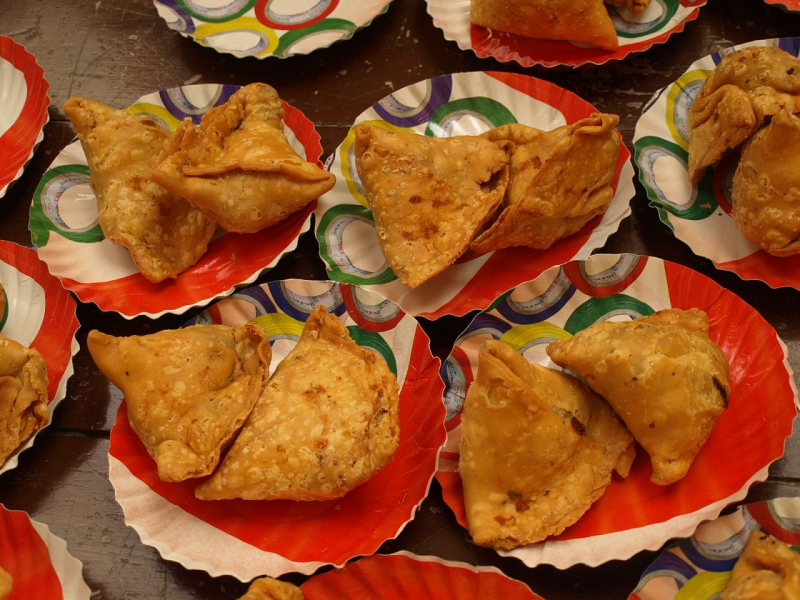
Screenshot of https://commons.wikimedia.org/wiki/File:Samosa_at_BarCampMumbai4.jpg Video by Epicurious -
Bhel Puri is a delightful Indian street food with a perfect blend of crunch, spice, and tangy flavors. This popular snack originates from the bustling streets of Mumbai but has found its way into the hearts and taste buds of food enthusiasts across the country.
The key ingredients of Bhel Puri are puffed rice, known as murmura or mamra, mixed with an assortment of spices and chutneys. To this base, various other components are added, including finely chopped onions, tomatoes, boiled potatoes, and a medley of savory and crunchy elements like sev (thin noodles) and roasted peanuts.
The real magic of Bhel Puri lies in its combination of chutneys. Tamarind chutney adds a sweet and tangy dimension, while green chutney, made from mint and coriander, brings in a refreshing, spicy kick. The dish is typically seasoned with spices like chaat masala and cumin powder.
Bhel Puri is all about the perfect balance of flavors and textures. Each bite offers a mix of crispy, crunchy, and soft elements, creating a symphony of tastes in your mouth. Whether enjoyed as a quick street food snack or at home, Bhel Puri is a culinary delight that exemplifies the colorful and diverse world of Indian street cuisine.
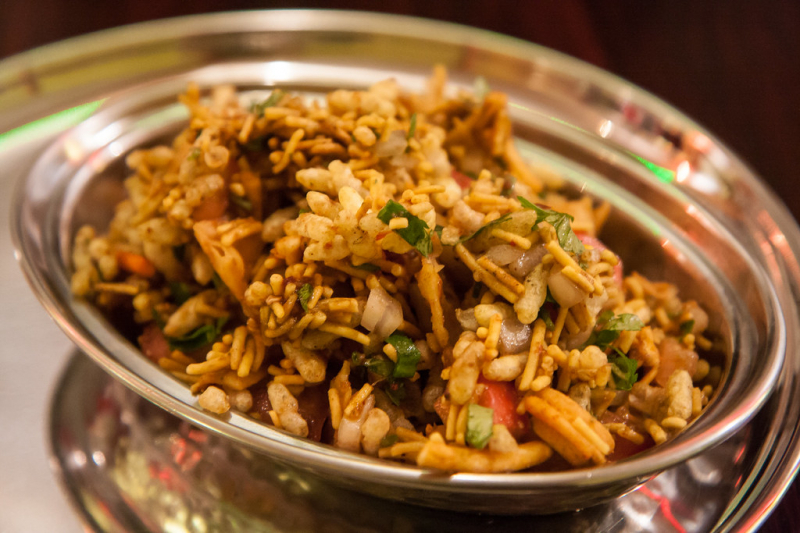
Screenshot of https://www.flickr.com/photos/garrettziegler/13649673743 Video by Aamchi Mumbai -
Vada Pav, often referred to as the "Indian burger," is a beloved street food originating from the bustling streets of Mumbai. This flavorful snack consists of a spiced potato fritter known as the "vada" sandwiched between a soft pav (a kind of bun), creating a delightful handheld meal.
The vada is made from mashed and seasoned potatoes, which are coated in a gram flour batter and deep-fried to a crispy golden brown. The spiced potato filling is rich with flavors like cumin, mustard seeds, and chopped green chilies, giving it a mildly spicy kick.
The pav, akin to a small bun, is typically toasted with a layer of chutney made from garlic, tamarind, and red chili powder, which adds a spicy and tangy element. The vada is placed within this bun, creating a perfect balance of textures and tastes.
Vada Pav is not just a snack; it's an iconic part of Mumbai's culinary identity. It's affordable, accessible, and immensely satisfying. The combination of the flavorful vada and the soft pav, along with the tangy chutney, makes it a favorite street food choice for people on the go. Vada Pav is a testament to the street food culture in India, where simplicity and bold flavors come together to create culinary magic.
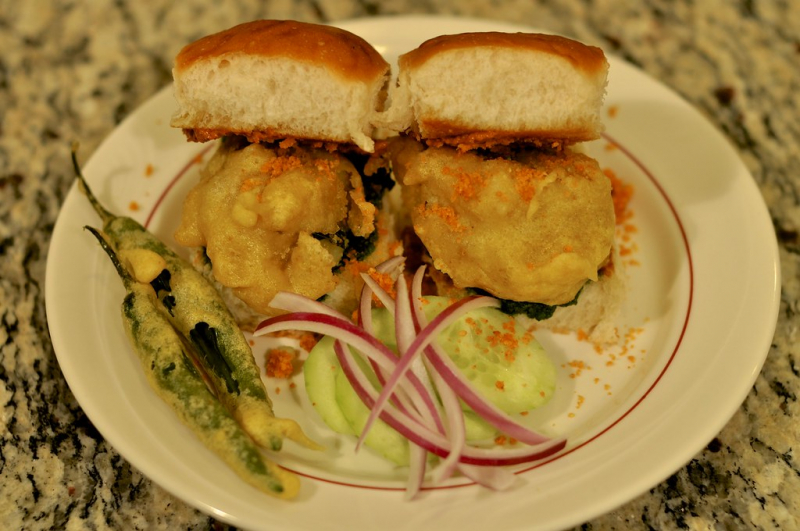
Screenshot of https://www.flickr.com/photos/40726522@N02/12280231155/ Video by Aamchi Mumbai -
The fifth item on the list of the top 15 most popular Indian street foods is Chaat, a diverse and beloved category of Indian street food celebrated for its flavorful and tantalizing taste. Chaat, which means "to lick" in Hindi, is an apt name for this cuisine, as it often leaves people craving more.
Chaat dishes come in a variety of forms, but they all share common elements. A typical chaat consists of a medley of ingredients, including crispy fried dough, diced potatoes, chickpeas, and a blend of spices and chutneys. The spices and chutneys vary depending on the specific type of chaat.
One popular chaat is Aloo Tikki, which features spiced potato patties served with chutneys and yogurt. Another favorite is Papri Chaat, which includes crispy flatbreads, yogurt, and a delightful mix of spices and chutneys.
The essence of chaat lies in its balance of flavors and textures, with sweet, savory, tangy, and spicy elements coming together to create a party in your mouth. It's not just a snack; it's a culinary celebration. Chaat is enjoyed on the streets of India, at homes, and in restaurants, offering a diverse and thrilling culinary experience that showcases the vibrant and complex flavors of Indian cuisine.
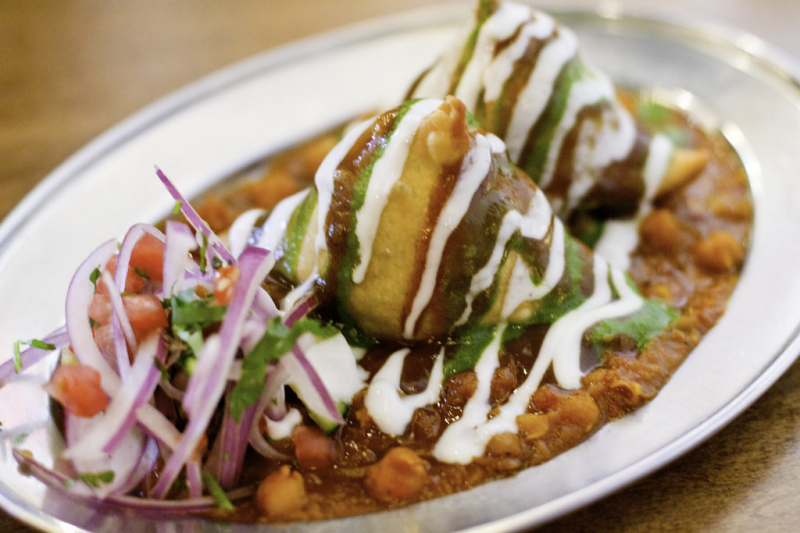
Screenshot of https://www.flickr.com/photos/pulaw/15334396887 Video by Aamchi Mumbai -
Jalebi is a sweet and indulgent Indian dessert known for its coiled, syrup-soaked appearance. This treat has a deep-rooted place in Indian culinary traditions and is a staple at celebrations and festivals.
The process of making jalebi begins with a batter of fermented maida (all-purpose flour) or urad dal (black gram flour). The batter is piped into spiral or pretzel-like shapes and deep-fried until it becomes crispy and golden.
After frying, the jalebis are soaked in sugar syrup, which imparts a sugary, syrupy goodness. The syrup is often infused with cardamom or saffron to add a fragrant and aromatic touch. Jalebi is enjoyed for its sweet and crunchy exterior, which contrasts with the syrup's sticky, sugary coating. It's a dessert that not only tantalizes the taste buds but also offers a visually appealing presentation with its bright orange-red color.
Jalebi is a popular dessert, especially during festivities, weddings, and other special occasions. It's a quintessential part of Indian sweets, showcasing the country's love for intricate and sweet delicacies. Whether served hot or at room temperature, jalebi remains a beloved treat, offering a delightful blend of textures and flavors.
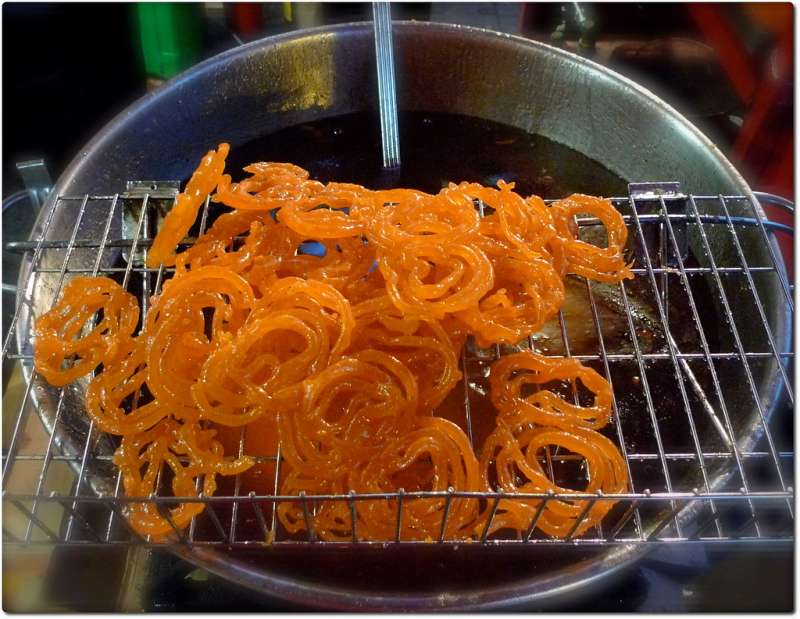
Screenshot of https://www.flickr.com/photos/swamibu/3189114754 Video by Yummyyy y -
Chole Bhature is a cherished North Indian dish that combines the heartiness of spiced chickpea curry, known as "chole," with the indulgence of deep-fried bread, called "bhature." This flavorful duo is a favorite for both breakfast and lunch in many North Indian households and restaurants.
Chole, the spiced chickpea curry, is prepared with a blend of aromatic spices like cumin, coriander, and garam masala, along with tomatoes, onions, and ginger-garlic paste. The chickpeas are simmered in this rich, tomato-based gravy until they become tender and infused with savory flavors.
Bhature, the deep-fried bread, is a soft and fluffy flatbread made from a dough that includes flour, yogurt, and a leavening agent like baking powder or soda. These dough balls are rolled out into large rounds and then deep-fried until they puff up and become golden and crispy.
Chole Bhature is typically served with a side of pickles, yogurt, and sometimes raw onions. The combination of the spiced, aromatic chickpea curry and the crispy yet soft bhature creates a delightful interplay of textures and flavors. It's a filling and satisfying meal that highlights the culinary richness of North India.
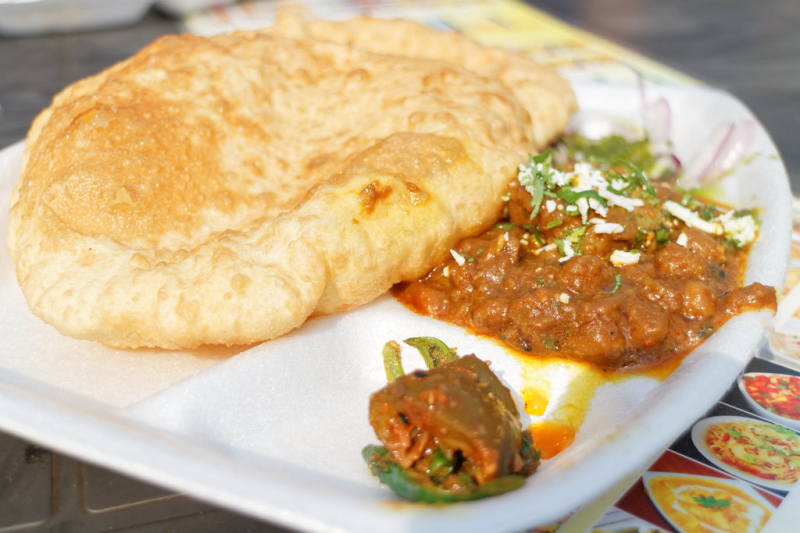
Screenshot of https://www.flickr.com/photos/nadircruise/17573549190 Video by VICE Asia -
Aloo Paratha is a popular and comforting Indian flatbread stuffed with a spiced potato filling. This classic North Indian dish combines the goodness of a crispy, whole wheat bread (paratha) with a flavorful mixture of mashed potatoes and spices.
To make Aloo Paratha, the dough is prepared by mixing whole wheat flour with water and a pinch of salt. The dough is then divided into small balls and rolled out into flat discs. Meanwhile, the potato filling is prepared by mashing boiled potatoes and adding spices like cumin, coriander, green chilies, and garam masala. The potato mixture is placed in the center of the rolled-out dough, and the dough is folded over, sealing the filling inside. It's then rolled out into a flatbread again, ready for cooking.
Aloo parathas are cooked on a hot griddle or skillet with a bit of ghee or oil, resulting in a crispy and golden crust. The interior is soft and filled with spiced potato goodness. These parathas are often served with yogurt, pickles, and sometimes a dollop of butter. Aloo Paratha is a wholesome and delightful meal enjoyed across India, known for its comforting, homemade flavors.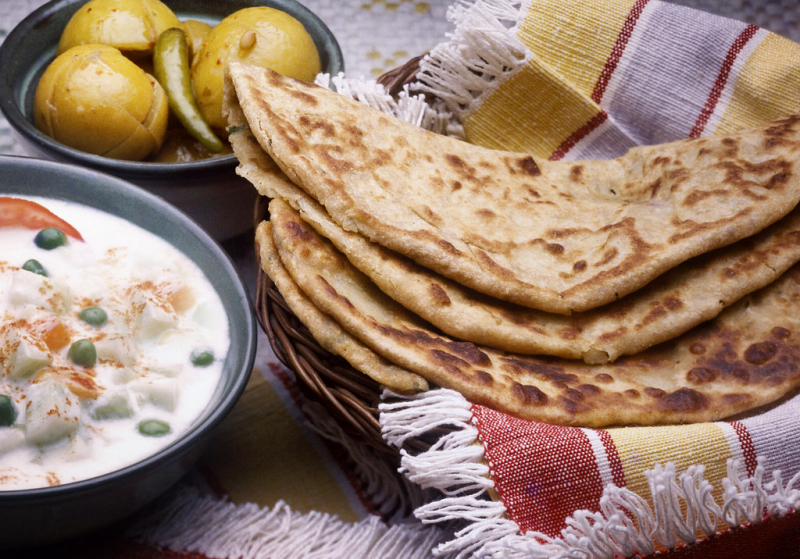
Screenshot of https://www.flickr.com/photos/askmir/36522722540 Video by HomeCookingShow -
Kathi roll is a popular Indian street food that's essentially a portable and flavorful wrap. It hails from the bustling streets of Kolkata but has gained nationwide recognition for its delectable taste.
The foundation of a Kathi roll is a paratha, a type of flatbread that's flaky and soft. This paratha is often cooked with ghee (clarified butter) and serves as a warm and delightful envelope for the filling.
The filling can vary, making it versatile for different tastes. It can include succulent grilled meats, such as chicken or lamb, or a vegetarian medley of paneer (Indian cottage cheese) and vegetables. The filling is typically marinated in spices, often including green chilies, ginger, and garlic, which infuse the ingredients with bold and savory flavors.
The Kathi Roll is not complete without a drizzle of chutneys and sauces, usually a combination of mint chutney, tamarind sauce, and yogurt, providing both a cooling and tangy contrast to the rich and spicy filling.
Kathi rolls are not only a quick and delicious snack, but also a versatile and satisfying meal enjoyed both on the streets and in restaurants. They exemplify the diversity and vibrancy of Indian street food, offering a taste of the culinary creativity that defines the country's food culture.
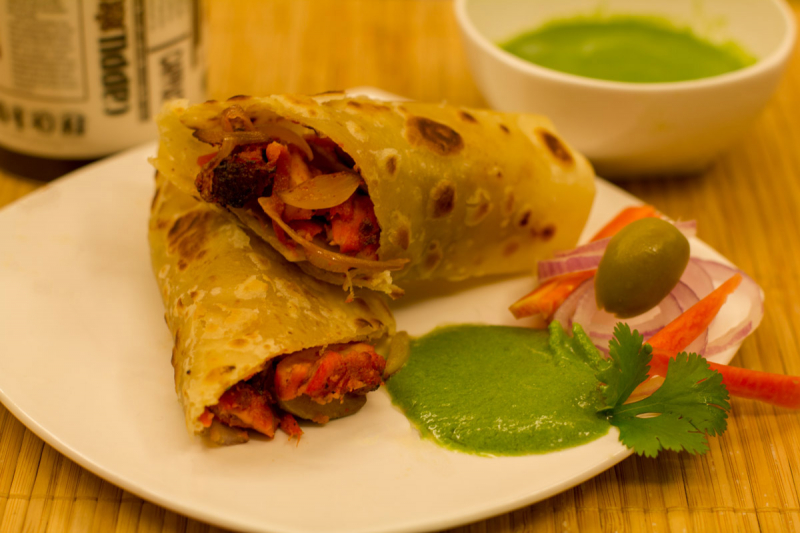
Screenshot of https://commons.wikimedia.org/wiki/File:Chicken-kathi-roll-recipe.jpg Video by Your Food Lab -
Masala Dosa is a beloved South Indian dish that has captured the hearts and palates of food lovers worldwide. This classic vegetarian meal consists of a thin, crispy rice crepe (dosa) filled with a spiced potato mixture (masala).
The dosa itself is a work of culinary art made from fermented rice and urad dal (black gram) batter. It's spread thinly on a hot griddle and cooked until it becomes golden and crispy, creating a delicate, paper-thin crepe.
The masala, the flavorful filling, is prepared by spicing up boiled potatoes with mustard seeds, turmeric, curry leaves, and other aromatic spices. This mixture is then generously spread onto the dosa, and the crepe is folded to encase the masala.
Masala dosa is traditionally served with coconut chutney, a spicy tomato-based chutney, and sambar, a lentil-based vegetable stew. The combination of the crispy dosa, flavorful masala, and a variety of accompaniments offers a delightful medley of tastes and textures.
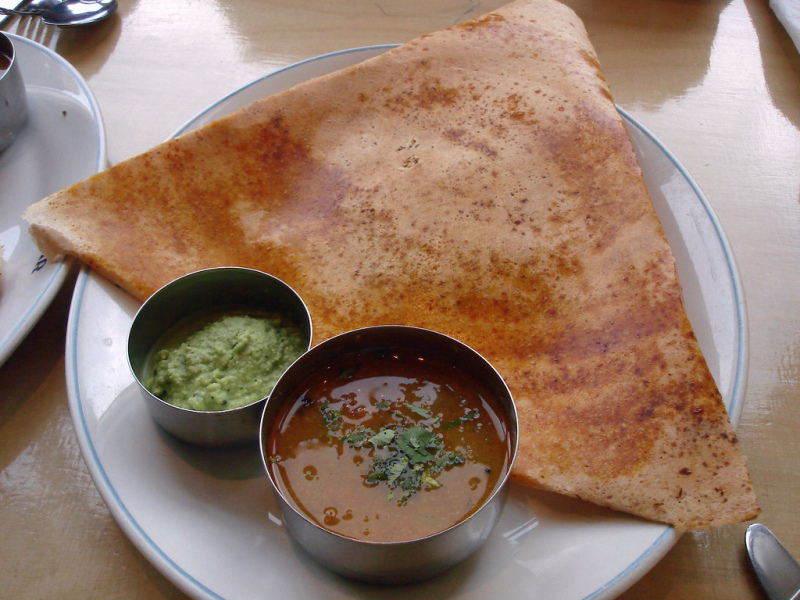
Screenshot of https://www.flickr.com/photos/su-lin/3291396228 -
Masala Chai, a beloved and aromatic beverage, is a cornerstone of Indian culture, cherished for its rich history and captivating flavors. The term "chai" simply means "tea" in Hindi, but Masala Chai is far more than just a generic beverage; it is a symphony of spices, warmth, and tradition.
At the heart of Masala Chai is a robust black tea, typically Assam or Darjeeling, which serves as the canvas for an enchanting blend of spices. The spices can vary, but common additions include cinnamon, cardamom, cloves, ginger, and black pepper. These spices are skillfully combined and simmered with the tea leaves in a mixture of milk and water, creating a harmonious infusion of flavors.
What distinguishes Masala Chai is the cozy and comforting experience it offers. The aroma of the spices mingles with the robustness of the tea, creating a fragrant and soul-warming elixir. The combination of spices not only adds depth and complexity to the flavor but also provides potential health benefits, making Masala Chai more than just a delicious beverage.
Masala chai is deeply ingrained in Indian culture, serving as a symbol of hospitality and togetherness. It is offered to guests as a gesture of warmth and welcome, and it's a daily ritual for countless individuals across the country. Whether sipped at street stalls or enjoyed in the comfort of one's home, Masala Chai is a sensory journey that transcends borders and cultures, inviting everyone to experience the magic of India's beloved spiced tea.
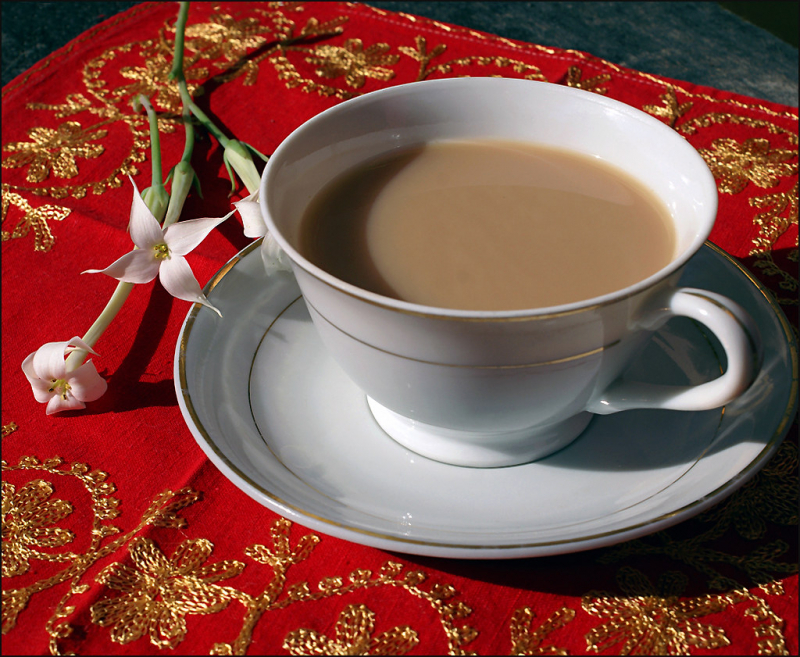
Screenshot of https://www.flickr.com/photos/uteart/3206781456 Video by Travel Thirsty -
Dahi Vada, a popular Indian dish, is a delectable combination of textures and flavors that makes it a beloved addition to Indian cuisine. This dish consists of soft lentil dumplings (vadas) soaked in creamy yogurt (dahi) and generously garnished with an array of spices and chutneys.
The preparation of Dahi Vada begins with soaking lentils, typically urad dal or moong dal, which are ground into a smooth batter. This batter is then fried into small, fluffy dumplings. Once the vadas are fried to golden perfection, they are soaked in water to remove excess oil and then squeezed to make them soft and spongy.
The next step involves immersing the vadas in a pool of fresh and creamy yogurt. The yogurt is often seasoned with a mixture of spices like cumin, red chili powder, and black salt, adding layers of flavor to the dish. To enhance the overall taste, sweet and tangy tamarind chutney and spicy green chutney are drizzled over the yogurt-drenched vadas, providing a delightful contrast of flavors.
Dahi Vada is a popular street food across India and a staple at festive occasions, weddings, and family gatherings. Its refreshing and harmonious blend of sweet, savory, and tangy flavors, coupled with the contrast of soft vadas and creamy yogurt, makes it a dish that's both comforting and indulgent.
Whether enjoyed as an appetizer or a side dish, Dahi Vada is a tantalizing treat that has a permanent place in the hearts of Indian food enthusiasts.
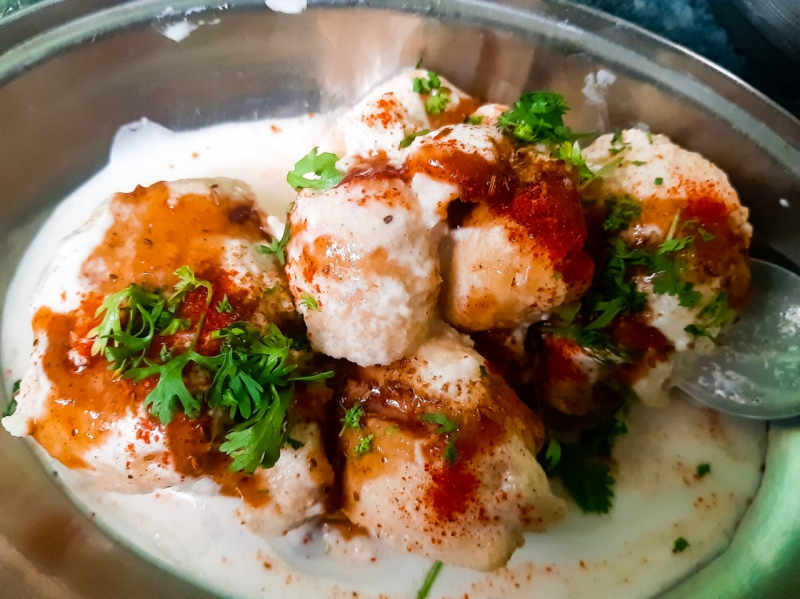
Screenshot of https://commons.wikimedia.org/wiki/File:Dahi_Vada_Bihari_Style.jpg Video by MadhurasRecipe Marathi -
Kachori, a beloved Indian snack, is a deep-fried, flaky pastry that encapsulates a flavorful filling. This iconic dish is cherished across India for its delicious taste and versatility.
The preparation of kachori begins with a spiced, coarsely ground lentil or flour-based filling, often made from ingredients like yellow moong dal, urad dal, or a mixture of spices and herbs. The dough for the outer shell is typically made from wheat flour, ghee, and water, creating a pliable and stretchy texture. The dough is divided into small portions, rolled into balls, and flattened into small discs. A spoonful of the filling is placed in the center, and the dough is carefully sealed, forming a pocket or ball.
The filled kachori is then deep-fried to golden perfection, resulting in a crispy, flaky exterior that encases the savory and spiced interior. The contrast of textures is a hallmark of this delicious snack. Kachori comes in various regional variations, such as the Rajasthani dal kachori, filled with spiced lentils, and the North Indian potato-filled aloo kachori.
Kachori is a popular street food often found at roadside stalls and local markets, where it's served hot and fresh. Its ability to be both a quick, satisfying snack and a flavorful accompaniment to meals has made it a beloved choice across India. Whether enjoyed on its own or as part of a larger feast, kachori showcases India's diverse culinary heritage and the art of transforming simple ingredients into a mouthwatering delight.
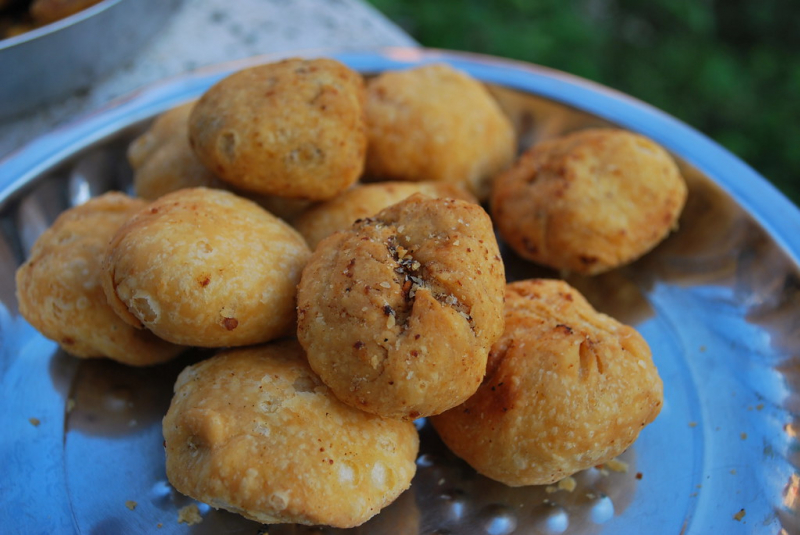
Screenshot of https://www.flickr.com/photos/mynameisharsha/2983170728 Video by Hebbars Kitchen -
Aloo Tikki, a cherished Indian street food, is a delightful spiced potato patty that captivates palates with its crispy exterior and flavorful, tender interior. This iconic snack is a popular choice across India, known for its comforting and savory taste.
The preparation of Aloo Tikki begins with boiling and mashing potatoes, which are then combined with an array of spices, including cumin, coriander, red chili powder, and garam masala. The mixture is skillfully seasoned and shaped into small, round patties. These patties are shallow-fried until they develop a golden, crispy crust, providing a satisfying textural contrast with the soft, spiced potato filling.
Aloo tikki is a versatile snack that can be enjoyed in various forms. It is often served on its own as a street food delicacy, topped with tangy tamarind chutney, mint chutney, and a sprinkle of chaat masala. Alternatively, it can be used as a base for more elaborate dishes like Aloo Tikki Chaat, where the patties are garnished with yogurt, onions, and an assortment of savory and sweet chutneys.
This beloved snack is not only a popular choice at street food stalls but also a cherished part of festive celebrations and family gatherings. Its comforting taste and fragrant blend of spices make it a versatile and beloved addition to India's diverse culinary landscape. Aloo Tikki is a tantalizing testament to the art of transforming simple ingredients into a flavorful masterpiece that continues to be a source of delight for Indian food enthusiasts.
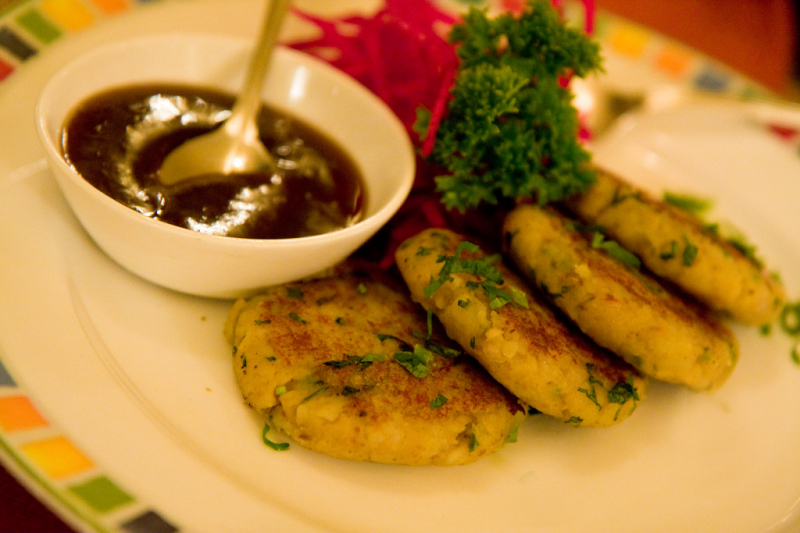
Screenshot of https://www.flickr.com/photos/garrettziegler/6737341207 Video by Hebbars Kitchen -
The final position in the list of the top 15 most popular Indian street foods is Kulfi, a sumptuous frozen dessert that is a beloved and timeless treat in India and offers a rich and creamy alternative to traditional ice cream. With its origins deeply rooted in the Indian subcontinent, Kulfi has become a symbol of traditional sweets and indulgence.
The process of making kulfi involves simmering milk until it reduces and thickens, creating a rich and velvety base. The condensed milk is then infused with flavors, which can range from classics like cardamom, saffron, and pistachio to more contemporary variations like mango or rose. The mixture is poured into molds and frozen, typically without the churning process associated with traditional ice cream. This results in a denser and creamier texture with a pronounced depth of flavor.
Kulfi is often enjoyed on a stick, making it a convenient and portable treat. It is also available in a variety of flavors, and it can be served as a slice or scoop for a more decadent experience. The finishing touch often includes garnishes like chopped nuts or a drizzle of rose or saffron syrup.
Beyond its delightful taste and texture, Kulfi represents a cultural connection to India's culinary heritage. It is a treat enjoyed at festive occasions, celebrations, and by the young and old alike. Whether relished on a bustling street corner or savored in a fine dining setting, Kulfi offers a taste of India's sweet traditions and the enduring allure of creamy, flavorful desserts.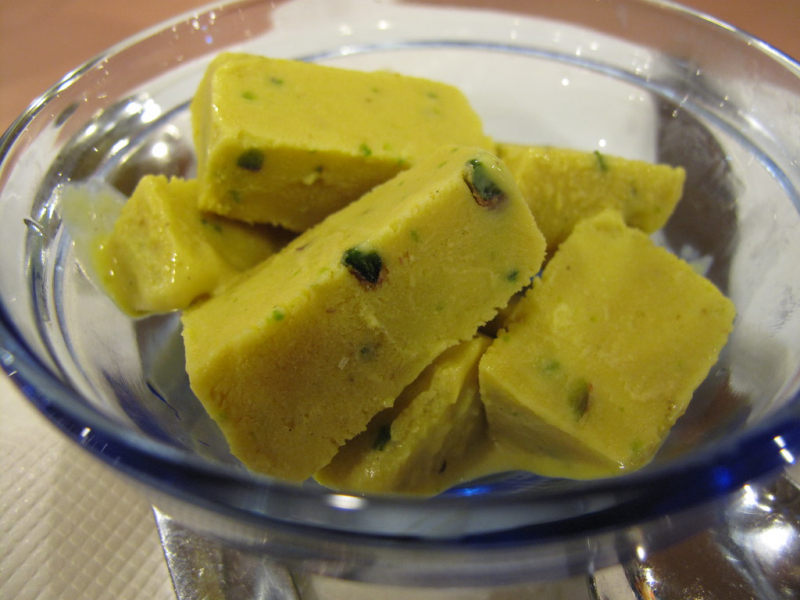
Screenshot of https://www.flickr.com/photos/backpackfoodie/4422035130 Video by Hebbars Kitchen

















